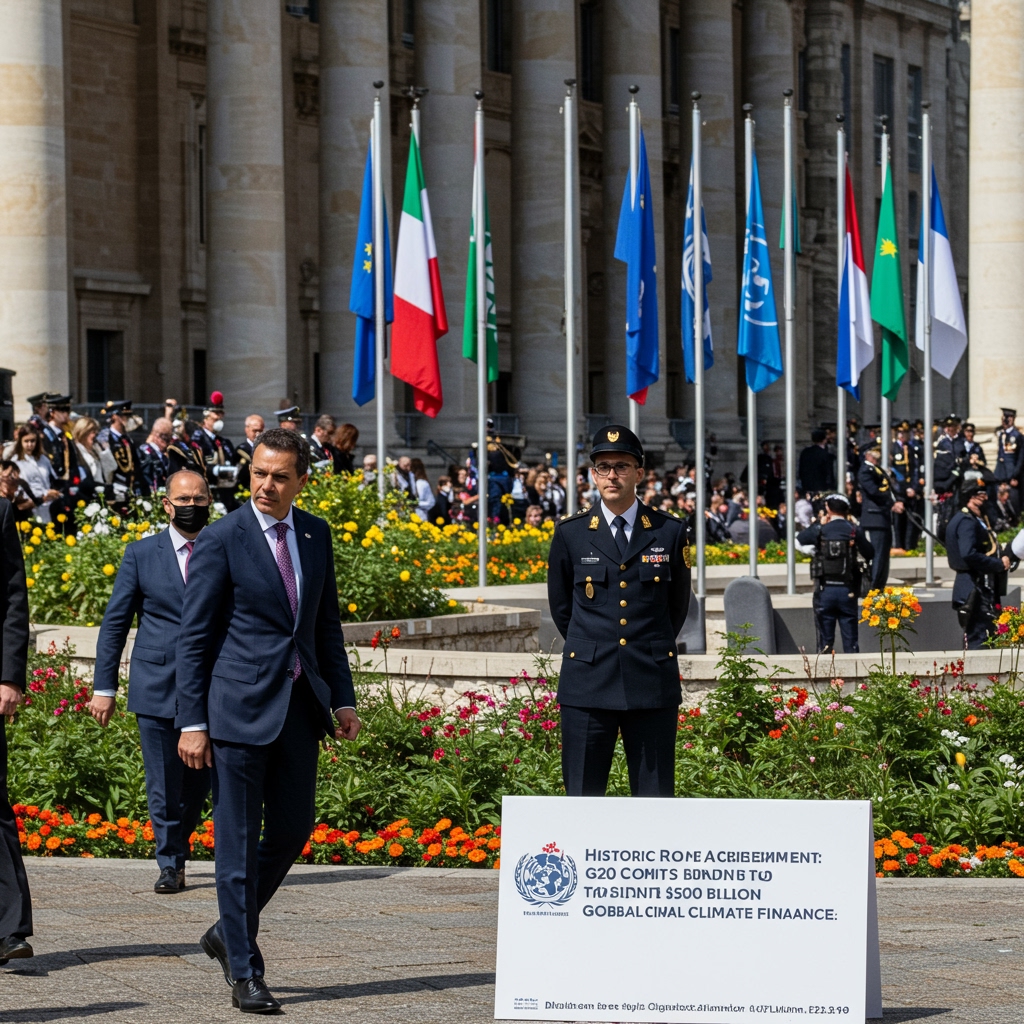G20 Nations Unveil Landmark $500 Billion Climate Finance Framework in Rome
Rome, Italy – Leaders from the Group of Twenty (G20) nations concluded their high-stakes summit in Rome today, announcing a significant and ambitious agreement on a new global climate finance framework. The culmination of intense negotiations saw the world’s major economies unite behind a plan designed to significantly accelerate climate action in developing countries over the coming half-decade.
The core of the agreement is a substantial financial commitment totaling $500 billion designated specifically for climate-related initiatives. This substantial sum is earmarked for deployment over the next five years, focusing primarily on crucial areas necessary for a global transition to a sustainable future and adaptation to the impacts of a changing climate. The funds are targeted towards bolstering renewable energy infrastructure and supporting critical climate adaptation projects in developing nations.
Details of the Landmark Framework
The agreed-upon framework represents a concerted effort by G20 members to mobilize financial resources at a scale commensurate with the global climate challenge. The $500 billion commitment for the next five years is intended to serve as a catalyst for investment in clean energy technologies and resilient infrastructure where it is most needed.
The focus on renewable energy infrastructure is paramount, aiming to facilitate the transition away from fossil fuels by supporting the development of solar, wind, geothermal, and other clean power sources. This includes investments in grids, storage solutions, and associated technologies essential for a robust renewable energy sector.
Simultaneously, the framework addresses the urgent need for climate adaptation. Funding is directed towards projects that help developing countries build resilience against the increasing impacts of climate change, such as rising sea levels, extreme weather events, and water scarcity. Adaptation projects could include initiatives like developing drought-resistant crops, building protective infrastructure in coastal areas, improving water management systems, and strengthening early warning systems.
Crucially, the framework explicitly targets developing countries, recognizing their disproportionate vulnerability to climate impacts and their need for financial and technological support to pursue low-carbon development pathways. The agreement underscores a shared responsibility, albeit with differentiated capabilities, in tackling the global climate crisis.
Bridging Key Divides: US-China Collaboration
A significant breakthrough leading to this agreement involved the successful bridging of earlier divides between key nations, most notably the United States and China. The two largest economies and emitters had previously held differing views on the mechanisms and responsibilities for contributing to global climate finance.
Sources close to the negotiations indicated that intensive bilateral discussions and a willingness to compromise on specific contribution mechanisms paved the way for the final accord. The alignment between the United States and China on this framework is seen as particularly vital, given their central roles in global emissions and the international climate dialogue. Their agreement provides significant momentum and credibility to the framework.
The resolution of these differences allowed for consensus on a structure that facilitates burden-sharing and leverages the financial capabilities of all G20 members. While specific country-by-country breakdowns of contributions were not immediately detailed in the public announcement, the overall commitment of $500 billion over five years reflects a collective pledge by the group as a whole.
Mechanisms for Implementation: Technology and Capacity
Beyond the financial commitment, the new climate finance framework places a strong emphasis on supporting mechanisms critical for effective climate action: technology transfer and capacity building. Recognizing that finance alone is insufficient, the agreement stresses the importance of ensuring that developing countries have access to the necessary technologies and expertise to implement renewable energy and adaptation projects successfully.
Technology transfer involves facilitating access to and deployment of advanced clean energy technologies, such as efficient solar panels, advanced battery storage, and carbon capture technologies. This could take the form of licensing agreements, joint ventures, or support for local manufacturing capabilities.
Capacity building initiatives outlined in the framework aim to strengthen the institutional and human capacities within developing nations. This includes training local professionals in areas such as project planning, renewable energy system maintenance, climate risk assessment, and policy development. The goal is to empower these countries to independently plan, implement, and manage their climate action strategies effectively.
The integration of technology transfer and capacity building alongside financial support is designed to create a more holistic and sustainable approach to climate finance, moving beyond simple aid to fostering long-term self-sufficiency in climate resilience and clean development.
Expert Reaction and Future Challenges
Experts and environmental organizations were quick to react to the announcement, largely hailing the agreement as a critical step towards meeting global climate goals. Many acknowledged the political will demonstrated by the G20 in overcoming significant hurdles to reach this consensus.
Analysts noted that while the $500 billion figure over five years is substantial and a positive development, particularly the alignment between the United States and China, the true test will lie in the implementation phase. Challenges remain in translating this high-level commitment into tangible projects on the ground in developing countries.
PwC Global Climate Leader, Dr. Emily Carter, commented, “This Rome agreement sends a powerful signal. The scale of finance is significant, and the emphasis on technology transfer and capacity building is exactly what’s needed to ensure funds translate into real emissions reductions and enhanced resilience. However, the complexity of project pipelines and ensuring funds reach the most vulnerable communities efficiently will require sustained effort and transparency.”
Other experts highlighted the need for clarity on how the funds will be disbursed, governed, and tracked to ensure accountability and effectiveness. Overcoming bureaucratic hurdles, ensuring local buy-in, and adapting projects to diverse local contexts will be crucial implementation challenges.
In conclusion, the Rome G20 summit yielded a potentially transformative climate finance framework. The commitment of $500 billion over the next five years, targeting renewable energy and adaptation in developing countries, supported by technology transfer and capacity building, and underpinned by a rare consensus between the United States and China, marks a significant moment. While the path ahead for implementation presents its own set of challenges, the agreement provides a vital financial backbone for accelerating global climate action in the critical years ahead.





